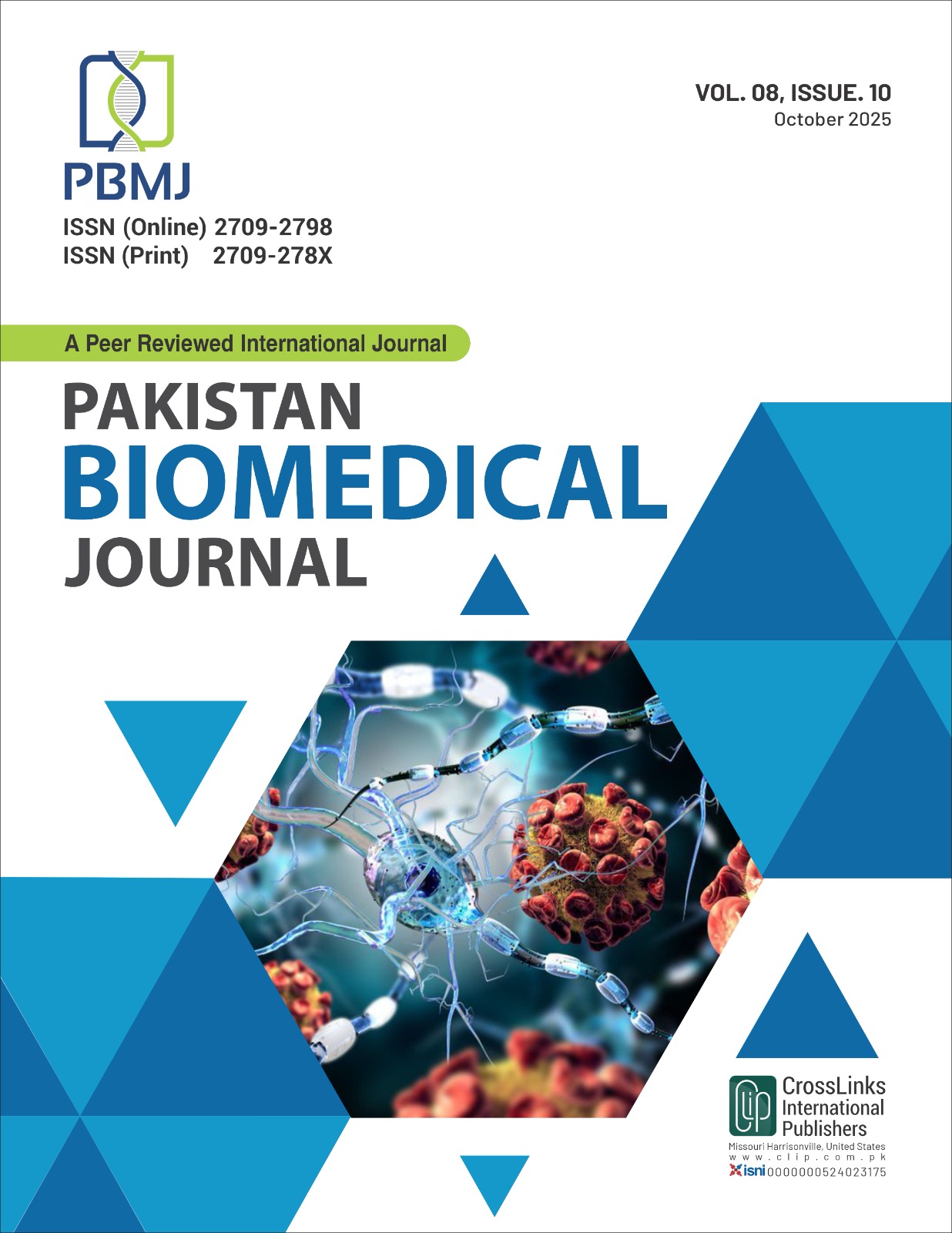Production and Evaluation of Polyclonal Antibodies Against Surface Protein of Mycobacterium tuberculosis: Diagnostic and Vaccine Implications
Polyclonal Antibodies Against Surface Protein of Mycobacterium tuberculosis
DOI:
https://doi.org/10.54393/pbmj.v8i10.1315Abstract
Mycobacterium tuberculosis (MTB), which causes tuberculosis (TB), is a significant health threat in the world. The diagnosis of early active and latent TB is still a problem. Serological methods have potential benefits of offering a fast and cost-effective diagnosis, although they need to be further refined to become clinically reliable. Objectives: To generate and test polyclonal antibodies (pAbs) of surface proteins of MTB as a potentially useful immunodiagnostic application. Methods: Extraction of surface proteins of MTB was done with the use of PBS and Tween-20, and rabbits were immunized with antigen-adjuvant mixtures. The serum was gathered, and titers of antibodies were determined by an indirect ELISA. Results: Rabbits vaccinated against the surface proteins of MTB generated high-titer antibodies, and the median absorbance of the 1:1600 dilution was 1.42 0.15, which was significantly higher (p<0.001) when compared to their controls that were not immunized. The endpoint titer, which was 1:12,800, was geometric, indicating that immunization and antibody were successful. Conclusions: The paper shows that it is possible to produce polyclonal antibodies against the proteins of the surface of Mycobacterium tuberculosis, which is going to serve as a basis for the future development of serological diagnostic instruments.
References
Moule MG and Cirillo JD. Mycobacterium Tuberculosis Dissemination Plays a Critical Role in Pathogenesis. Frontiers in Cellular and Infection Microbiology. 2020 Feb; 10: 65. doi: 10.3389/fcimb.2020.00065. DOI: https://doi.org/10.3389/fcimb.2020.00065
Wei M, Zhao Y, Qian Z, Yang B, Xi J, Wei J et al. Pneumonia Caused by Mycobacterium Tuberculosis. Microbes and Infection. 2020 Jul; 22(6-7): 278-84. doi: 10.1016/j.micinf.2020.05.020. DOI: https://doi.org/10.1016/j.micinf.2020.05.020
Nguyen KH, Alcantara CA, Glassman I, May N, Mundra A, Mukundan A et al. Cutaneous Manifestations of Mycobacterium Tuberculosis: A Literature Review. Pathogens. 2023 Jul; 12(7): 920. doi: 10.3390/pathogens12070920. DOI: https://doi.org/10.3390/pathogens12070920
Kontsevaya I, Cabibbe AM, Cirillo DM, DiNardo AR, Frahm N, Gillespie SH et al. Update on the Diagnosis of Tuberculosis. Clinical Microbiology and Infection. 2024 Sep; 30(9): 1115-22. doi: 10.1016/j.cmi.2023.07.014. DOI: https://doi.org/10.1016/j.cmi.2023.07.014
Heidary M, Shirani M, Moradi M, Goudarzi M, Pouriran R, Rezaeian T et al. Tuberculosis Challenges: Resistance, Co-Infection, Diagnosis, and Treatment. European Journal of Microbiology and Immunology. 2022 Apr; 12(1): 1-7. doi: 10.1556/1886.2021.00021. DOI: https://doi.org/10.1556/1886.2021.00021
Hu Z, Lu SH, Lowrie DB, Fan XY. Research Advances for Virus-Vectored Tuberculosis Vaccines and Latest Findings on Tuberculosis Vaccine Development. Frontiers in Immunology. 2022 Jun; 13: 895020. doi: 10.3389/fimmu.2022.895020. DOI: https://doi.org/10.3389/fimmu.2022.895020
Obeagu EI and Obeagu GU. Human Immunodeficiency Virus and Tuberculosis Infection: A Review of Prevalence of Associated Factors. International Journal of Advanced Multidisciplinary Research. 2023; 10(10): 56-62.
Melkie ST, Arias L, Farroni C, Makek MJ, Goletti D, Vilaplana C. The Role of Antibodies in Tuberculosis Diagnosis, Prophylaxis and Therapy: A Review from the ESGMYC Study Group. European Respiratory Review. 2022 Mar; 31(163). doi: 10.1183/16000617.0218-2021. DOI: https://doi.org/10.1183/16000617.0218-2021
Ma Z, Ji X, Yang H, He J, Zhang Q, Wang Y et al. Screening and Evaluation of Mycobacterium Tuberculosis Diagnostic Antigens. European Journal of Clinical Microbiology and Infectious Diseases. 2020 Oct; 39(10): 1959-70. doi: 10.1007/s10096-020-03951-3. DOI: https://doi.org/10.1007/s10096-020-03951-3
Beatty WL and Russell DG. Identification of Mycobacterial Surface Proteins Released into Subcellular Compartments of Infected Macrophages. Infection and Immunity. 2000 Dec; 68(12): 6997-7002. doi: 10.1128/IAI.68.12.6997-7002.2000. DOI: https://doi.org/10.1128/IAI.68.12.6997-7002.2000
Govindarajan DK and Kandaswamy K. Virulence Factors of Uropathogens and Their Role in Host Pathogen Interactions. The Cell Surface. 2022 Dec; 8: 100075. doi: 10.1016/j.tcsw.2022.100075. DOI: https://doi.org/10.1016/j.tcsw.2022.100075
Farnia P, Zhavnerko GK, Farnia P, Poleschuyk NN, Ghanavi J, Velayati AA. Identification of Seven Types of Pili in Mycobacterium Tuberculosis: Using Atomic Force Microscopy. The International Journal of Mycobacteriology. 2023 Oct; 12(4): 478-85. doi: 10.4103/ijmy.ijmy_190_23. DOI: https://doi.org/10.4103/ijmy.ijmy_190_23
Perley CC, Frahm M, Click EM, Dobos KM, Ferrari G, Stout JE et al. The Human Antibody Response to the Surface of Mycobacterium Tuberculosis. PLOS One. 2014 Jun; 9(6): e98938. doi: 10.1371/journal.pone.0098938. DOI: https://doi.org/10.1371/journal.pone.0098938
Grange JM, Gibson J, Nassau E, Kardjito T. Enzyme-Linked Immunosorbent Assay (ELISA): A Study of Antibodies to Mycobacterium Tuberculosis in the Igg, Iga and Igm Classes in Tuberculosis, Sarcoidosis and Crohn's Disease. Tubercle. 1980 Sep; 61(3): 145-52. doi: 10.1016/0041-3879(80)90003-3. DOI: https://doi.org/10.1016/0041-3879(80)90003-3
An Y, Ni R, Zhuang L, Yang L, Ye Z, Li L et al. Tuberculosis Vaccines and Therapeutic Drug: Challenges and Future Directions. Molecular Biomedicine. 2025 Jan; 6(1): 4. doi: 10.1186/s43556-024-00243-6. DOI: https://doi.org/10.1186/s43556-024-00243-6
Yan Z, Guo J, Wu J, Zhang H, Ma T. Generation of Novel Polyclonal Antibodies Against Mycobacterium Tuberculosis Lipoarabinomannan, EspB, and Mtb8. Applied Microbiology and Biotechnology. 2025 Sep; 109(1): 200. doi: 10.1007/s00253-025-13588-x. DOI: https://doi.org/10.1007/s00253-025-13588-x
Andersen ÅB and Brennan P. Proteins and Antigens of Mycobacterium Tuberculosis. Tuberculosis: Pathogenesis, Protection, and Control. 1994 May: 307-32. doi: 10.1128/9781555818357.ch21. DOI: https://doi.org/10.1128/9781555818357.ch21
Anderloni G. Development and Qualification of Bioassays for the Determination of the Bioactivity, Predictive Pharmacokinetics and Potential Immunogenicity of Therapeutic Antibodies. 2021.
Tabatabaei MS and Ahmed M. Enzyme-Linked Immunosorbent Assay (ELISA). In Cancer Cell Biology: Methods and Protocols. 2022 Jun: 115-134. doi: 10.1007/978-1-0716-2376-3_10. DOI: https://doi.org/10.1007/978-1-0716-2376-3_10
Chen C, Han X, Yan Q, Wang C, Jia L, Taj A et al. The Inhibitory Effect of GlmU Acetyltransferase Inhibitor TPSA on Mycobacterium Tuberculosis May Be Affected Due to Its Methylation by Methyltransferase Rv0560c. Frontiers in Cellular and Infection Microbiology. 2019 Jul; 9: 251. doi: 10.3389/fcimb.2019.00251. DOI: https://doi.org/10.3389/fcimb.2019.00251
Downloads
Published
How to Cite
Issue
Section
License
Copyright (c) 2025 Pakistan BioMedical Journal

This work is licensed under a Creative Commons Attribution 4.0 International License.
This is an open-access journal and all the published articles / items are distributed under the terms of the Creative Commons Attribution License, which permits unrestricted use, distribution, and reproduction in any medium, provided the original author and source are credited. For comments editor@pakistanbmj.com











